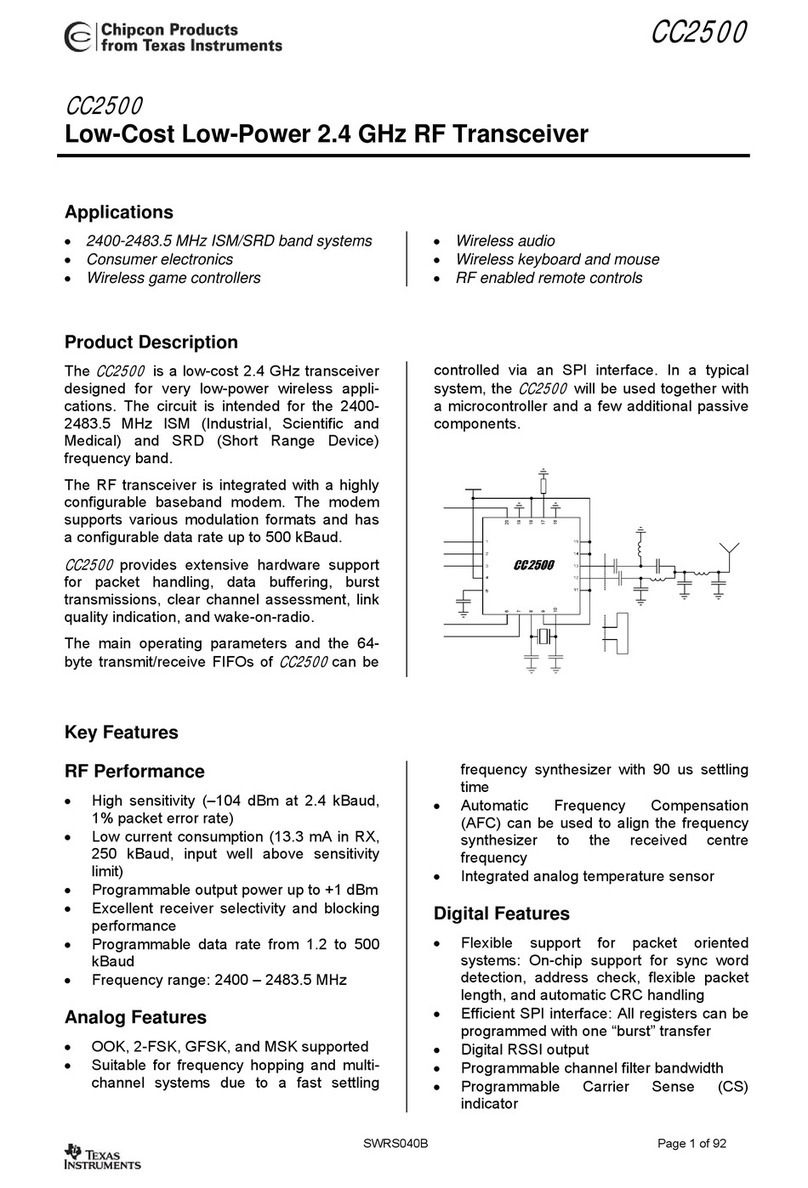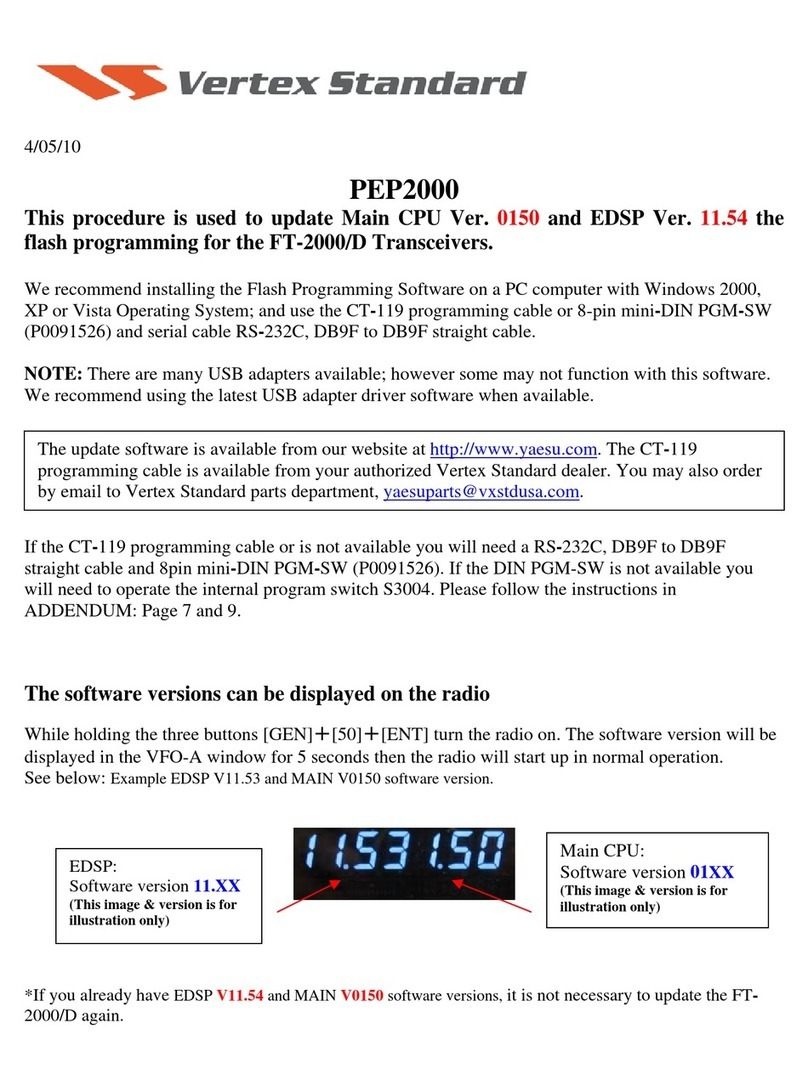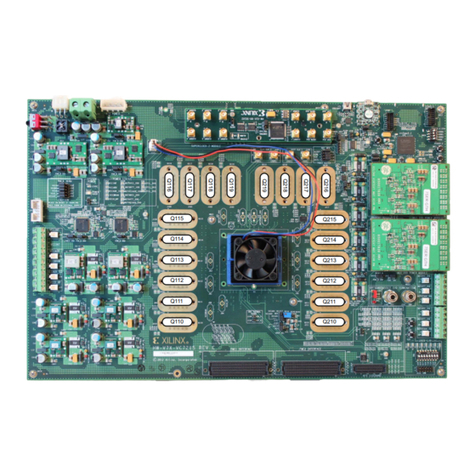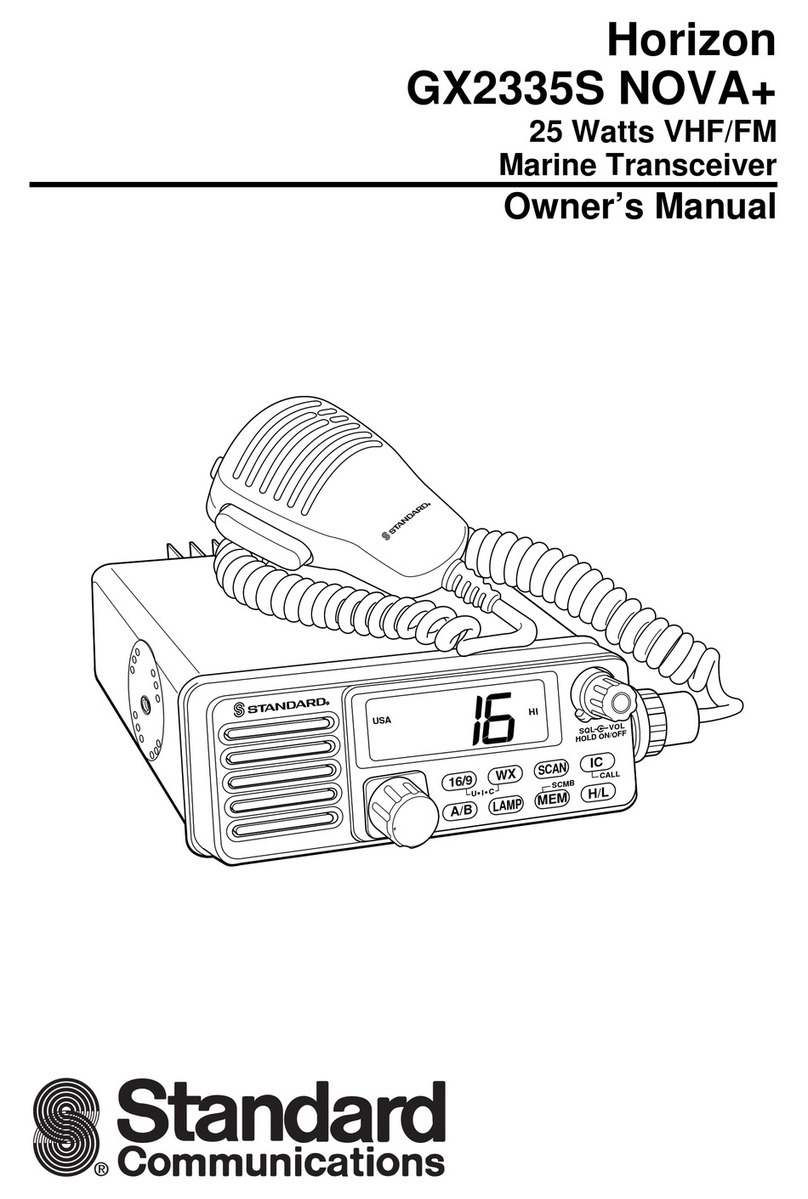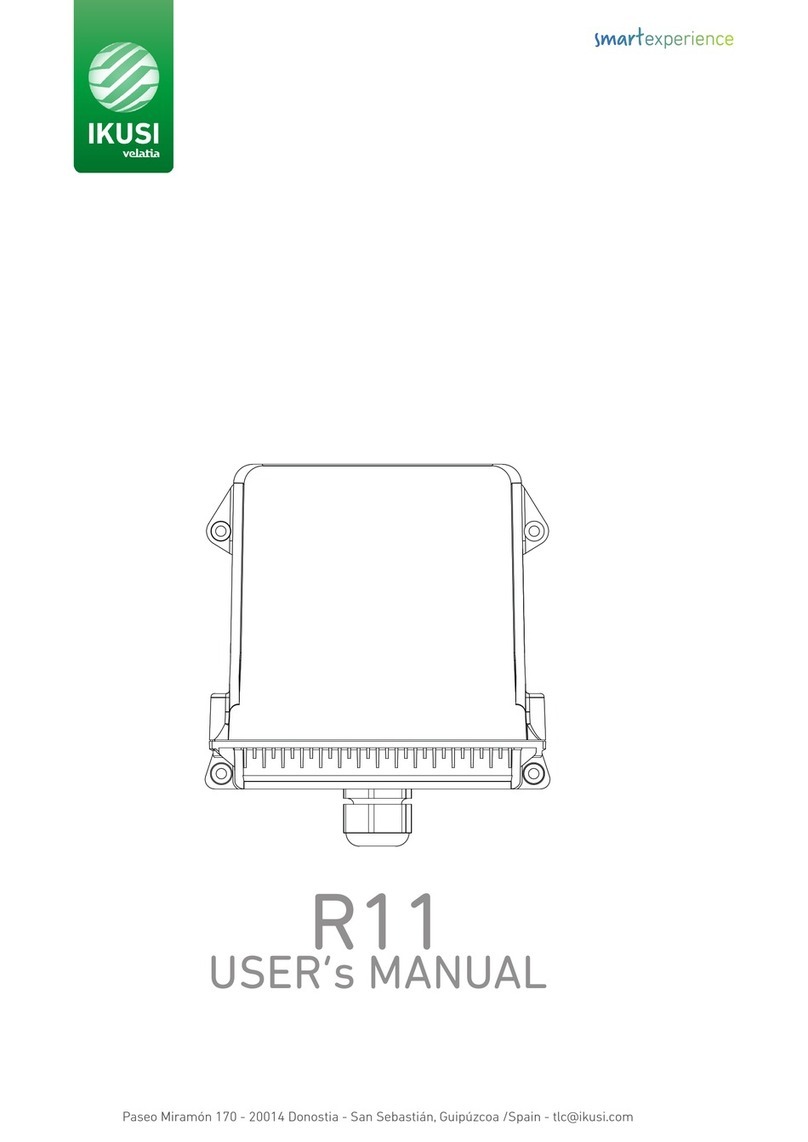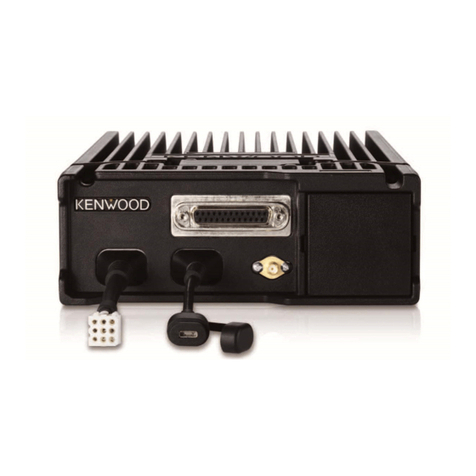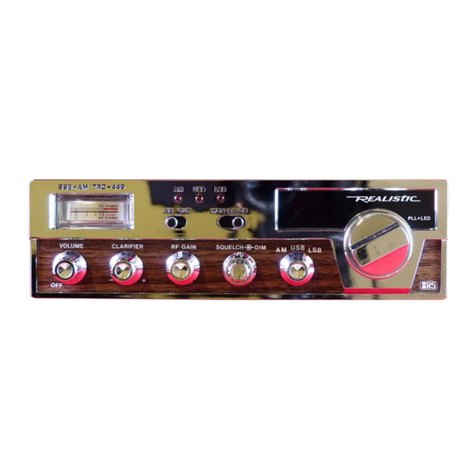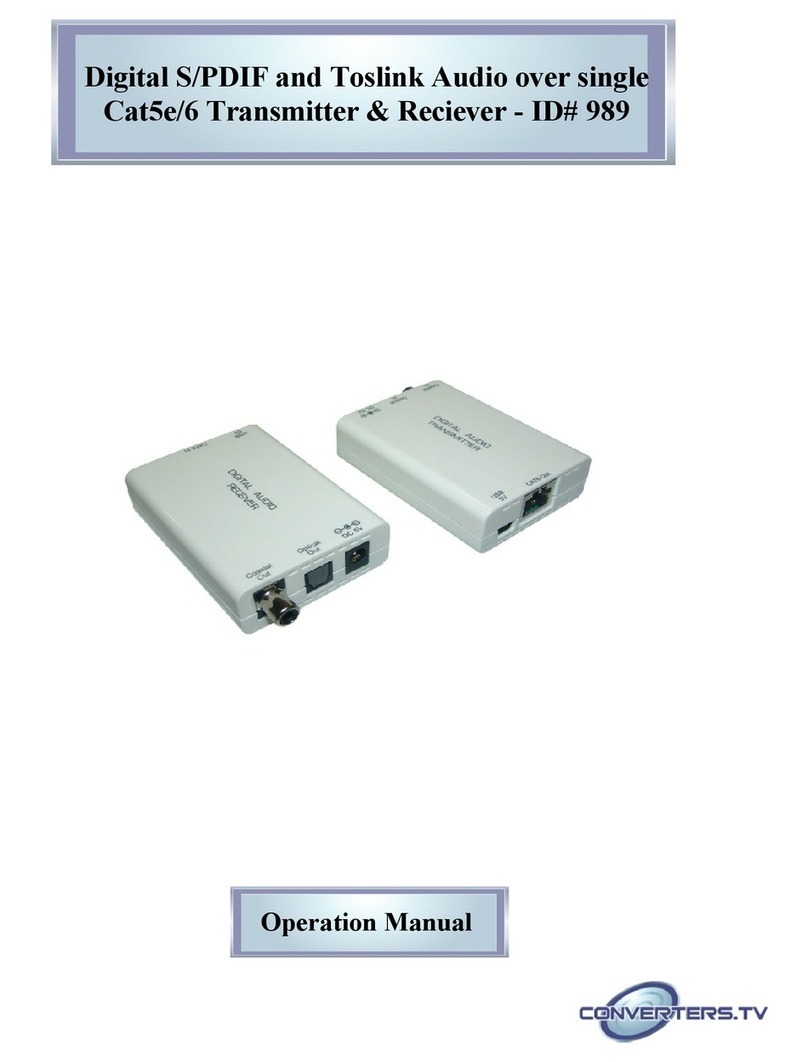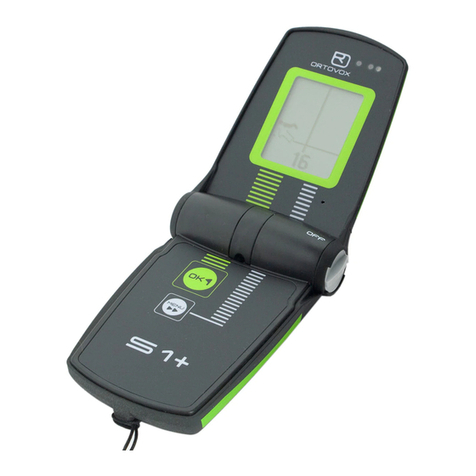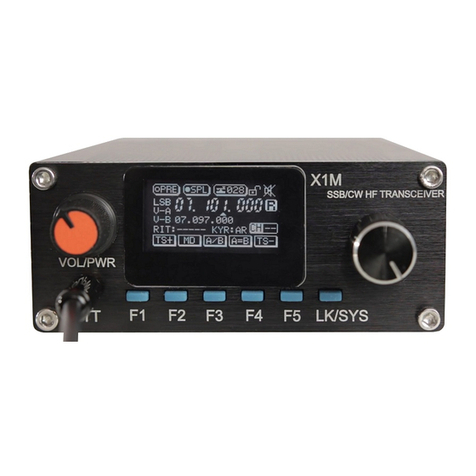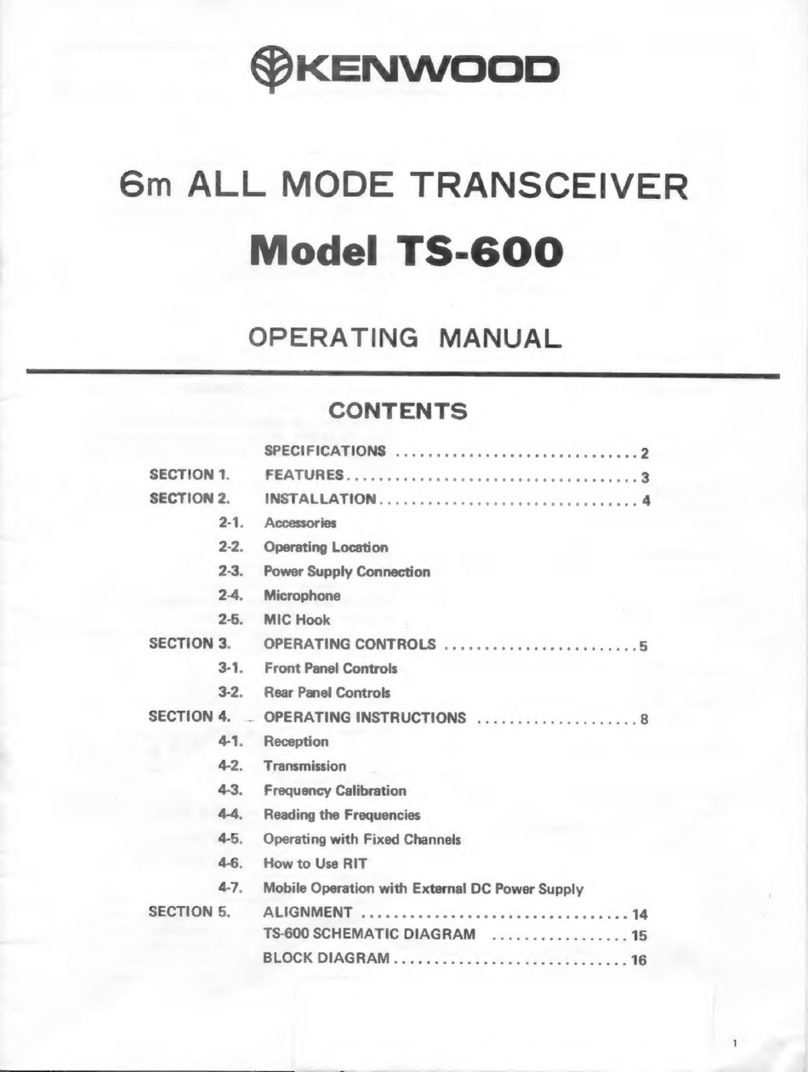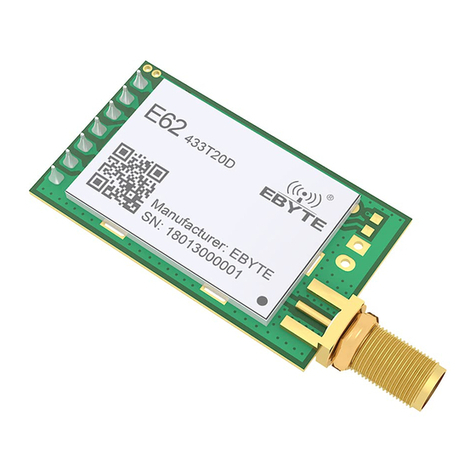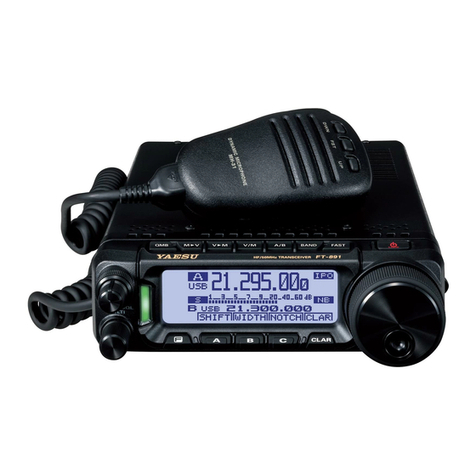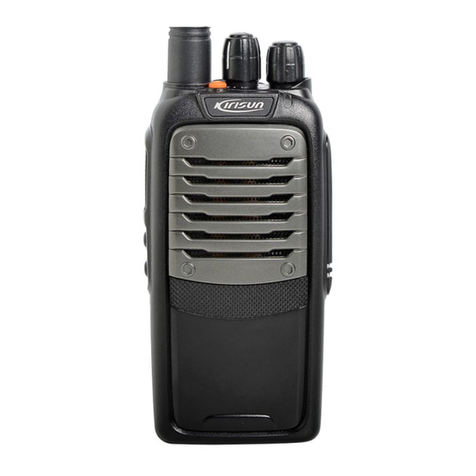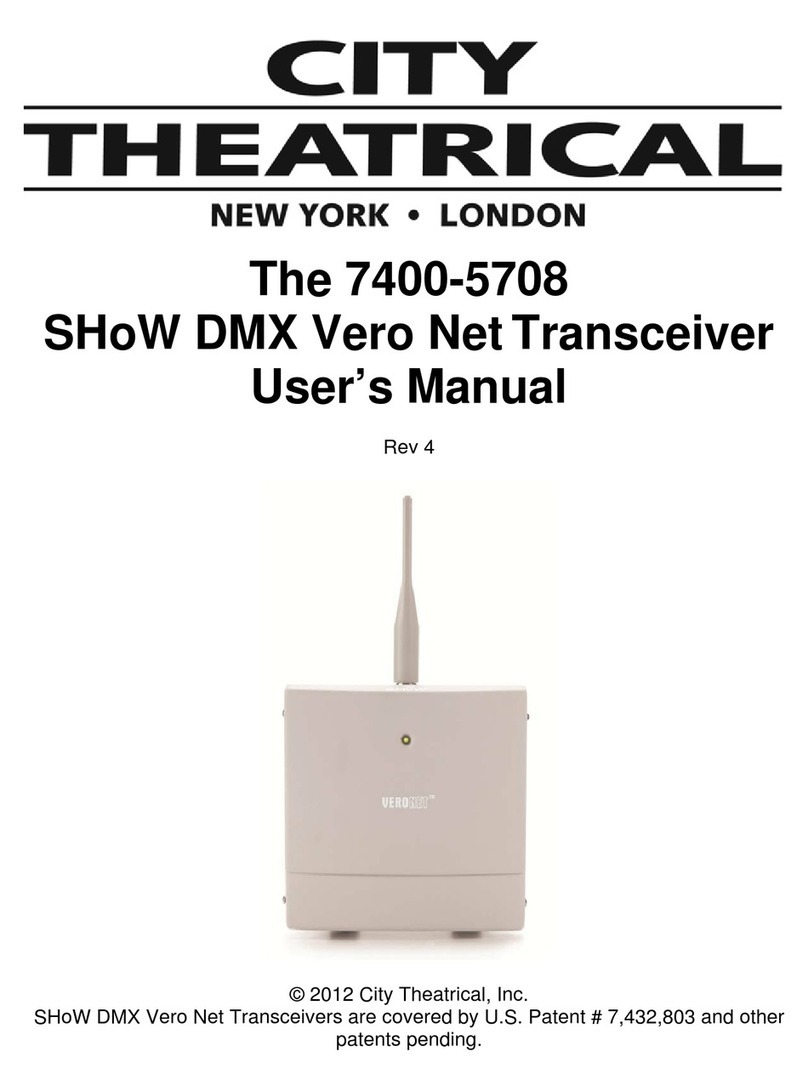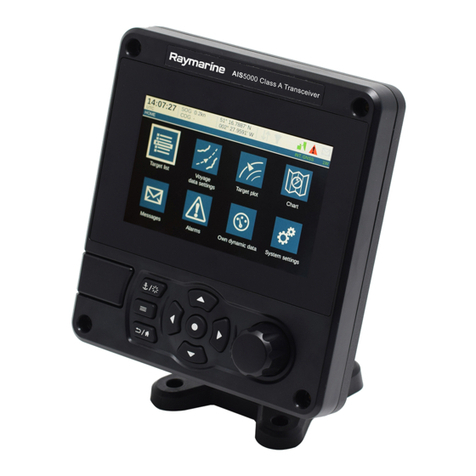Chipcon CC1000 User manual

CC1000
SWRS048A Page 1 of 55
CC1000
Single Chip Very Low Power RF Transceiver
Applications
•Very low power UHF wireless data
transmitters and receivers
•315 / 433 / 868 and 915 MHz ISM/SRD
band systems
•RKE – Two-way Remote Keyless Entry
•Home automation
•Wireless alarm and security systems
•AMR – Automatic Meter Reading
•Low power telemetry
•Game Controllers and advanced toys
Product Description
CC1000
is a true single-chip UHF trans-
ceiver designed for very low power and
very low voltage wireless applications. The
circuit is mainly intended for the ISM
(Industrial, Scientific and Medical) and
SRD (Short Range Device) frequency
bands at 315, 433, 868 and 915 MHz, but
can easily be programmed for operation at
other frequencies in the 300-1000 MHz
range.
The main operating parameters of
CC1000
can be programmed via a serial bus, thus
making
CC1000
a very flexible and easy to
use transceiver. In a typical system
CC1000
will be used together with a
microcontroller and a few external passive
components.
CC1000
is based on Chipcon’s SmartRF®
technology in 0.35 µm CMOS.
Features
•True single chip UHF RF transceiver
•Very low current consumption
•Frequency range 300 – 1000 MHz
•Integrated bit synchroniser
•High sensitivity (typical -110 dBm at 2.4
kBaud)
•Programmable output power –20 to
10 dBm
•Small size (TSSOP-28 or UltraCSP™
package)
•Low supply voltage (2.1 V to 3.6 V)
•Very few external components required
•No external RF switch / IF filter
required
•RSSI output
•Single port antenna connection
•FSK data rate up to 76.8 kBaud
•Complies with EN 300 220 and FCC
CFR47 part 15
•Programmable frequency in 250 Hz
steps makes crystal temperature drift
compensation possible without TCXO
•Suitable for frequency hopping
protocols
•Development kit available
•Easy-to-use software for generating the
CC1000
configuration data

CC1000
SWRS048A Page 2 of 55
Table of Contents
CC1000
...........................................................................................................................1
Single Chip Very Low Power RF Transceiver...........................................................1
1. Absolute Maximum Ratings...................................................................................4
2. Operating Conditions .............................................................................................4
3. Electrical Specifications.........................................................................................4
4. Pin Assignment.......................................................................................................8
5. Circuit Description..................................................................................................9
6. Application Circuit................................................................................................10
6.1 Input / output matching...............................................................................................10
6.2 VCO inductor..............................................................................................................10
6.3 Additional filtering.......................................................................................................10
6.4 Power supply decoupling ...........................................................................................10
7. Configuration Overview .......................................................................................12
8. Configuration Software ........................................................................................12
9. 3-wire Serial Configuration Interface ..................................................................13
Note: The set-up- and hold-times refer to 50% of VDD..........................................14
10. Microcontroller Interface....................................................................................15
10.1 Connecting the microcontroller ................................................................................15
11. Signal interface...................................................................................................16
11.1 Manchester encoding and decoding........................................................................16
12. Bit synchroniser and data decision ..................................................................19
13. Receiver sensitivity versus data rate and frequency separation....................22
14. Frequency programming....................................................................................23
15. Recommended RX settings for ISM frequencies .............................................24
16. VCO......................................................................................................................25
17. VCO and PLL self-calibration.............................................................................25
18. VCO and LNA current control............................................................................28
19. Power management............................................................................................28

CC1000
SWRS048A Page 3 of 55
20. Input / Output Matching......................................................................................31
21. Output power programming ..............................................................................32
22. RSSI output .........................................................................................................33
23. IF output ..............................................................................................................34
24. Crystal oscillator.................................................................................................35
25. Optional LC Filter................................................................................................36
26. System Considerations and Guidelines............................................................37
26.1 SRD regulations.......................................................................................................37
26.2 Low cost systems.....................................................................................................37
26.3 Battery operated systems.........................................................................................37
26.4 Crystal drift compensation........................................................................................37
26.5 High reliability systems.............................................................................................37
26.6 Frequency hopping spread spectrum systems.........................................................37
27. PCB Layout Recommendations.........................................................................38
28. Antenna Considerations.....................................................................................38
L = 7125 / f .................................................................................................................38
29. Configuration registers ......................................................................................39
30. Package Description (TSSOP-28)......................................................................48
31. Package Description (UltraCSP™) ....................................................................49
32. Plastic Tube Specification .................................................................................51
33. Waffle Pack Specification ..................................................................................51
34. Carrier Tape and Reel Specification..................................................................51
35. Ordering Information..........................................................................................52
36. General Information............................................................................................52
36.1 Document Revision History......................................................................................52
36.2 Product Status Definitions........................................................................................52
37. Address Information...........................................................................................54
38. TI Worldwide Technical Support .......................................................................54
39. Product Information Centers .............................................................................54

CC1000
SWRS048A Page 4 of 55
1. Absolute Maximum Ratings
Parameter Min. Max. Units Condition
Supply voltage, VDD -0.3 5.0 V
Voltage on any pin -0.3 VDD+0.3,
max 5.0 V
Input RF level 10 dBm
Storage temperature range
(TSSOP) -50 150
°C
Shelf life (UltraCSP™) 1 year Room temperature and oxygen
free cabinet
Reflow soldering temperature
(TSSOP) 260
°C IPC/JEDEC J-STD-020C
Peak reflow soldering temperature
(UltraCSP™) 255
°C IPC/JEDEC J-STD-020C
Under no circumstances the absolute
maximum ratings given above should be
violated. Stress exceeding one or more of
the limiting values may cause permanent
damage to the device.
Caution! ESD sensitive device.
Precaution should be used when handling
the device in order to prevent permanent
damage.
2. Operating Conditions
Parameter
Min. Typ. Max. Unit Condition / Note
RF Frequency Range 300
1000 MHz Programmable in steps of 250 Hz
Operating ambient temperature range -40 85 °C
Supply voltage
2.1 3.0 3.6 V
Note: The same supply voltage
should be used for digital (DVDD)
and analogue (AVDD) power.
3. Electrical Specifications
Tc = 25°C, VDD = 3.0 V if nothing else stated
Parameter
Min. Typ. Max. Unit Condition / Note
Transmit Section
Transmit data rate
0.6 76.8 kBaud NRZ or Manchester encoding.
76.8 kBaud equals 76.8 kbit/s
using NRZ coding. See page 16.
Binary FSK frequency separation
0 65 kHz
The frequency separation is
programmable in 250 Hz steps.
65 kHz is the maximum
guaranteed separation at 1 MHz
reference frequency. Larger
separations can be achieved at
higher reference frequencies.

CC1000
SWRS048A Page 5 of 55
Parameter
Min. Typ. Max. Unit Condition / Note
Output power
433 MHz
868 MHz
-20
-20
10
5
dBm
dBm
Delivered to 50 Ωload.
The output power is
programmable.
RF output impedance
433/868 MHz 140 / 80 ΩTransmit mode. For matching
details see “Input/ output
matching” p.31.
Harmonics
-20 dBc An external LC or SAW filter
should be used to reduce
harmonics emission to comply
with SRD requirements. See
p.36.
Receive Section
Receiver Sensitivity, 433 MHz
Optimum sensitivity (9.3 mA)
Low current consumption (7.4 mA)
Receiver Sensitivity, 868 MHz
Optimum sensitivity (11.8 mA)
Low current consumption (9.6 mA)
-110
-109
-107
-105
dBm
dBm
dBm
dBm
2.4 kBaud, Manchester coded
data, 64 kHz frequency
separation, BER = 10
-3
See Table 6 and Table 7 page 22
for typical sensitivity figures at
other data rates.
System noise bandwidth 30 kHz 2.4 kBaud, Manchester coded
data
Cascaded noise figure
433/868 MHz
12/13 dB
Saturation
10 dBm 2.4 kBaud, Manchester coded
data, BER = 10
-3
Input IP3
-18 dBm From LNA to IF output
Blocking
40 dBc At +/- 1 MHz
LO leakage -57 dBm
Input impedance
88-j26
70-j26
52-j7
52-j4
Ω
Ω
Ω
Ω
Receive mode, series equivalent
at 315 MHz
at 433 MHz
at 868 MHz.
At 915 MHz
For matching details see “Input/
output matching” p. 31.
Turn on time 11 128 Baud The turn-on time is determined by
the demodulator settling time,
which is programmable. See p.
19
IF Section
Intermediate frequency (IF)
150
10.7 kHz
MHz Internal IF filter
External IF filter
IF bandwidth
175 kHz
RSSI dynamic range
-105 -50 dBm
RSSI accuracy ±6
dB
See p.33 for details
RSSI linearity ±2 dB

CC1000
SWRS048A Page 6 of 55
Parameter
Min. Typ. Max. Unit Condition / Note
Frequency Synthesiser
Section
Crystal Oscillator Frequency
3 16 MHz Crystal frequency can be 3-4, 6-8
or 9-16 MHz. Recommended
frequencies are 3.6864, 7.3728,
11.0592 and 14.7456. See page
35 for details.
Crystal frequency accuracy
requirement
±50
±25
ppm 433 MHz
868 MHz
The crystal frequency accuracy
and drift (ageing and
temperature dependency) will
determine the frequency accuracy
of the transmitted signal.
Crystal operation
Parallel
C171 and C181 are loading
capacitors, see page 35
Crystal load capacitance
12
12
12
22
16
16
30
30
16
pF
pF
pF
3-4 MHz, 22 pF recommended
6-8 MHz, 16 pF recommended
9-16 MHz, 16 pF recommended
Crystal oscillator start-up time 5
1.5
2
ms
ms
ms
3.6864 MHz, 16 pF load
7.3728 MHz, 16 pF load
16 MHz, 16 pF load
Output signal phase noise
-85 dBc/Hz At 100 kHz offset from carrier
PLL lock time (RX / TX turn time)
200 µs Up to 1 MHz frequency step
PLL turn-on time, crystal oscillator
on in power down mode 250 µs Crystal oscillator running
Digital Inputs/Outputs
Logic “0” input voltage
0 0.3*VDD V
Logic ”1” input voltage
0.7*VDD VDD V
Logic “0” output voltage
0
0.4 V Output current -2.5 mA,
3.0 V supply voltage
Logic “1” output voltage
2.5
VDD V Output current 2.5 mA,
3.0 V supply voltage
Logic “0” input current
NA -1
µA Input signal equals GND
Logic “1” input current
NA 1
µA Input signal equals VDD
DIO setup time
20 ns TX mode, minimum time DIO
must be ready before the positive
edge of DCLK
DIO hold time
10 ns TX mode, minimum time DIO
must be held after the positive
edge of DCLK
Serial interface (PCLK, PDATA and
PALE) timing specification
See Table 2 page 14
Current Consumption
Power Down mode
0.2 1
µA Oscillator core off

CC1000
SWRS048A Page 7 of 55
Parameter
Min. Typ. Max. Unit Condition / Note
Current Consumption,
receive mode 433/868 MHz
7.4/9.6 mA Current is programmable and can
be increased for improved
sensitivity
Current Consumption,
average in receive mode using
polling 433/868 MHz
74/96 µA Polling controlled by micro-
controller using 1:100 receive to
power down ratio
Current Consumption,
transmit mode 433/868 MHz:
P=0.01mW (-20 dBm)
P=0.3 mW (-5 dBm)
P=1 mW (0 dBm)
P=3 mW (5 dBm)
P=10 mW (10 dBm)
5.3/8.6
8.9/13.8
10.4/16.5
14.8/25.4
26.7/NA
mA
mA
mA
mA
mA
The ouput power is delivered to a
50Ωload, see also p. 32
Current Consumption, crystal osc.
Current Consumption, crystal osc.
And bias
Current Consumption, crystal osc.,
bias and synthesiser, RX/TX
30
80
105
860
4/5
5/6
µA
µA
µA
µA
mA
mA
3-8 MHz, 16 pF load
9-14 MHz, 12 pF load
14-16 MHz, 16 pF load
< 500 MHz
> 500 MHz

CC1000
SWRS048A Page 8 of 55
4. Pin Assignment
Pin no. UltraCSP
pin no. Pin name Pin type Description
1 G3 AVDD Power (A) Power supply (3 V) for analog modules (mixer and IF)
2 F2 AGND Ground (A) Ground connection (0 V) for analog modules (mixer and IF)
3 G2 RF_IN RF Input RF signal input from antenna
4 G1 RF_OUT RF output RF signal output to antenna
5 F1 AVDD Power (A) Power supply (3 V) for analog modules (LNA and PA)
6 E2 AGND Ground (A) Ground connection (0 V) for analog modules (LNA and PA)
7 E1 AGND Ground (A) Ground connection (0 V) for analog modules (PA)
8 D1 AGND Ground (A) Ground connection (0 V) for analog modules (VCO and prescaler)
9 C1 AVDD Power (A) Power supply (3 V) for analog modules (VCO and prescaler)
10 B1 L1 Analog input Connection no 1 for external VCO tank inductor
11 A1 L2 Analog input Connection no 2 for external VCO tank inductor
12 B2 CHP_OUT
(LOCK) Analog output Charge pump current output
The pin can also be used as PLL Lock indicator. Output is high
when PLL is in lock.
13 C2 R_BIAS Analog output
Connection for external precision bias resistor (82 kΩ, ±1%)
14 F3 AGND Ground (A) Ground connection (0 V) for analog modules (backplane)
15 A2 AVDD Power (A) Power supply (3 V) for analog modules (general)
16 B3 AGND Ground (A) Ground connection (0 V) for analog modules (general)
17 A3 XOSC_Q2 Analog output Crystal, pin 2
18 A4 XOSC_Q1 Analog input Crystal, pin 1, or external clock input
19 B4 AGND Ground (A) Ground connection (0 V) for analog modules (guard)
20 C3 DGND Ground (D) Ground connection (0 V) for digital modules (substrate)
21 C4 DVDD Power (D) Power supply (3 V) for digital modules
22 D4 DGND Ground (D) Ground connection (0 V) for digital modules
23 E4 DIO Digital
input/output Data input/output. Data input in transmit mode. Data output in
receive mode
24 F4 DCLK Digital output Data clock for data in both receive and transmit mode
25 G4 PCLK Digital input Programming clock for 3-wire bus
26 D3 PDATA Digital
input/output Programming data for 3-wire bus. Programming data input for
write operation, programming data output for read operation
27 D2 PALE Digital input Programming address latch enable for 3-wire bus. Internal pull-up.
28 E3 RSSI/IF Analog output The pin can be used as RSSI or 10.7 MHz IF output to optional
external IF and demodulator. If not used, the pin should be left
open (not connected).
A=Analog, D=Digital
(Top View)
1
14 15
AVDD
AGND
RF_IN
RF_OUT
AVDD
AGND
AGND
AGND
AVDD
L1
L2
R_BIAS
CHP_OUT
AGND
CC1000
2
3
4
6
5
7
8
9
11
12
13
10
28
RSSI/IF
PALE
PDATA
PCLK
DCLK
DIO
DGND
DVDD
DGND
AGND
XOSC_Q1
AGND
XOSC_Q2
AVDD
27
26
25
23
24
22
21
20
18
17
16
19
1
14 15
AVDD
AGND
RF_IN
RF_OUT
AVDD
AGND
AGND
AGND
AVDD
L1
L2
R_BIAS
CHP_OUT
AGND
CC1000
2
3
4
6
5
7
8
9
11
12
13
10
28
RSSI/IF
PALE
PDATA
PCLK
DCLK
DIO
DGND
DVDD
DGND
AGND
XOSC_Q1
AGND
XOSC_Q2
AVDD
RSSI/IF
PALE
PDATA
PCLK
DCLK
DIO
DGND
DVDD
DGND
AGND
XOSC_Q1
AGND
XOSC_Q2
AVDD
27
26
25
23
24
22
21
20
18
17
16
19

CC1000
SWRS048A Page 9 of 55
5. Circuit Description
Figure 1. Simplified block diagram of the
CC1000
A simplified block diagram of
CC1000
is
shown in Figure 1. Only signal pins are
shown.
In receive mode
CC1000
is configured as a
traditional superheterodyne receiver. The
RF input signal is amplified by the low-
noise amplifier (LNA) and converted down
to the intermediate frequency (IF) by the
mixer (MIXER). In the intermediate
frequency stage (IF STAGE) this
downconverted signal is amplified and
filtered before being fed to the
demodulator (DEMOD). As an option a
RSSI signal, or the IF signal after the
mixer is available at the RSSI/IF pin. After
demodulation
CC1000
outputs the digital
demodulated data on the pin DIO.
Synchronisation is done on-chip providing
data clock at DCLK.
In transmit mode the voltage controlled
oscillator (VCO) output signal is fed
directly to the power amplifier (PA). The
RF output is frequency shift keyed (FSK)
by the digital bit stream fed to the pin DIO.
The internal T/R switch circuitry makes the
antenna interface and matching very easy.
The frequency synthesiser generates the
local oscillator signal which is fed to the
MIXER in receive mode and to the PA in
transmit mode. The frequency synthesiser
consists of a crystal oscillator (XOSC),
phase detector (PD), charge pump
(CHARGE PUMP), VCO, and frequency
dividers (/R and /N). An external crystal
must be connected to XOSC, and only an
external inductor is required for the VCO.
The 3-wire digital serial interface
(CONTROL) is used for configuration.
PDATA, PCLK, PALE
LNA
PA
DEMOD
VCO PD OSC
~
/N
MIXER
CHARGE
PUMP
L1
RF_IN DIO
CHP_OUT
IF STAGE
RF_OUT
RSSI/IF
3
CONTROL
XOSC_Q2
XOSC_Q1
/R
DCLK
L2
LPF
BIAS
R_BIAS
PDATA, PCLK, PALE
LNA
PA
DEMOD
VCO PD OSC
~
/N
MIXER
CHARGE
PUMP
L1
RF_IN DIO
CHP_OUT
IF STAGE
RF_OUT
RSSI/IF
3
CONTROL
XOSC_Q2
XOSC_Q1
/R
DCLK
L2
LPF
BIAS
R_BIAS

CC1000
SWRS048A Page 10 of 55
6. Application Circuit
Very few external components are
required for the operation of
CC1000
. A
typical application circuit is shown in
Figure 2. Component values are shown in
Table 1.
6.1 Input / output matching
C31/L32 is the input match for the
receiver. L32 is also a DC choke for
biasing. C41, L41 and C42 are used to
match the transmitter to 50 Ω. An internal
T/R switch circuit makes it possible to
connect the input and output together and
match the
CC1000
to 50 Ωin both RX and
TX mode. See “Input/output matching”
p.31 for details.
6.2 VCO inductor
The VCO is completely integrated except
for the inductor L101.
Component values for the matching
network and VCO inductor are easily
calculated using the SmartRF®Studio
software.
6.3 Additional filtering
Additional external components (e.g. RF
LC or SAW-filter) may be used in order to
improve the performance in specific
applications. See also “Optional LC filter”
p.36 for further information.
6.4 Power supply decoupling
Power supply decoupling and filtering
must be used (not shown in the
application circuit). The placement and
size of the decoupling capacitors and the
power supply filtering are very important to
achieve the optimum performance.
Chipcon provides reference designs
(CC1000PP and CC1000uCSP_EM) that
should be followed very closely.
Figure 2. Typical
CC1000
application circuit (power supply decoupling not shown)

CC1000
SWRS048A Page 11 of 55
CC1000 TSSOP package
Item 315 MHz 433 MHz 868 MHz 915 MHz
C31 8.2 pF, 5%, C0G, 0603 15 pF, 5%, C0G, 0603 10 pF, 5%, C0G, 0603 10 pF, 5%, C0G, 0603
C41 2.2 pF, 5%, C0G, 0603 8.2 pF, 5%, C0G, 0603 Not used Not used
C42 5.6 pF, 5%, C0G, 0603 5.6 pF, 5%, C0G, 0603 4.7 pF, 5%, C0G, 0603 4.7 pF, 5%, C0G, 0603
C171 18 pF, 5%, C0G, 0603 18 pF, 5%, C0G, 0603 18 pF, 5%, C0G, 0603 18 pF, 5%, C0G, 0603
C181 18 pF, 5%, C0G, 0603 18 pF, 5%, C0G, 0603 18 pF, 5%, C0G, 0603 18 pF, 5%, C0G, 0603
L32 39 nH, 10%, 0805
(Coilcraft 0805CS-390XKBC)
68 nH, 10%, 0805
(Coilcraft 0805CS-680XKBC)
120 nH, 10%, 0805
(Coilcraft 0805CS-121XKBC)
120 nH, 10%, 0805
(Coilcraft 0805CS-121XKBC)
L41 20 nH, 10%, 0805
(Coilcraft 0805HQ-
20NXKBC)
6.2 nH, 10%, 0805
(Coilcraft 0805HQ-
6N2XKBC)
2.5 nH, 10%, 0805
(Coilcraft 0805HQ-
2N5XKBC)
2.5 nH, 10%, 0805
(Coilcraft 0805HQ-
2N5XKBC)
L101 56 nH, 5%, 0805
(Koa KL732ATE56NJ)
33 nH, 5%, 0805
(Koa KL732ATE33NJ) 4.7 nH, 5%, 0805
(Koa KL732ATE4N7C) 4.7 nH, 5%, 0805
(Koa KL732ATE4N7C)
R131 82 kΩ, 1%, 0603 82 kΩ, 1%, 0603 82 kΩ, 1%, 0603 82 kΩ, 1%, 0603
XTAL 14.7456 MHz crystal,
16 pF load 14.7456 MHz crystal,
16 pF load 14.7456 MHz crystal,
16 pF load 14.7456 MHz crystal,
16 pF load
CC1000 UltraCSP™ package
Item 315 MHz 433 MHz 868 MHz 915 MHz
C31 8.2 pF, 5%, C0G, 0402 15 pF, 5%, C0G, 0402 10 pF, 5%, C0G, 0402 10 pF, 5%, C0G, 0402
C41 Not used Not used Not used Not used
C42 4.7 pF, 5%, C0G, 0402 4.7 pF, 5%, C0G, 0402 6.8 pF, 5%, C0G, 0402 6.8 pF, 5%, C0G, 0402
C171 18 pF, 5%, C0G, 0402 18 pF, 5%, C0G, 0402 18 pF, 5%, C0G, 0402 18 pF, 5%, C0G, 0402
C181 18 pF, 5%, C0G, 0402 18 pF, 5%, C0G, 0402 18 pF, 5%, C0G, 0402 18 pF, 5%, C0G, 0402
L32 39 nH, 5%, 0402
(Ceramic multilayer)
68 nH, 5%, 0402
(Ceramic multilayer)
120 nH, 5%, 0402
(Ceramic multilayer)
120 nH, 5%, 0402
(Ceramic multilayer)
L41 22 nH, 5%, 0402
(Ceramic multilayer)
15 nH, 5%, 0402
(Ceramic multilayer)
2.7 nH, 5%, 0402
(Ceramic multilayer)
2.7 nH, 5%, 0402
(Ceramic multilayer)
L101 56 nH, 5%, 0402
(Thin film inductor)
33 nH, 5%, 0402
(Thin film inductor) 7.5 nH, 5%, 0402
(Thin film inductor) 7.5 nH, 5%, 0402
(Thin film inductor)
R131 82 kΩ, 1%, 0402 82 kΩ, 1%, 0402 82 kΩ, 1%, 0402 82 kΩ, 1%, 0402
XTAL 14.7456 MHz crystal,
16 pF load 14.7456 MHz crystal,
16 pF load 14.7456 MHz crystal,
16 pF load 14.7456 MHz crystal,
16 pF load
Note: Items shaded are different for different frequencies
Table 1. Bill of materials for the application circuit
Note that the component values for
868/915 MHz can be the same. However,
it is important the layout is optimised for
the selected VCO inductor in order to
centre the tuning range around the
operating frequency to account for
inductor tolerance. The VCO inductor
must be placed very close and
symmetrical with respect to the pins (L1
and L2).
Chipcon provide reference layouts that
should be followed very closely in order to
achieve the best performance. The
reference design can be downloaded from
the Chipcon website.

CC1000
SWRS048A Page 12 of 55
7. Configuration Overview
CC1000
can be configured to achieve the
best performance for different
applications. Through the programmable
configuration registers the following key
parameters can be programmed:
•Receive / transmit mode
•RF output power
•Frequency synthesiser key
parameters: RF output frequency, FSK
frequency separation (deviation),
crystal oscillator reference frequency
•Power-down / power-up mode
•Crystal oscillator power-up / power
down
•Data rate and data format (NRZ,
Manchester coded or UART interface)
•Synthesiser lock indicator mode
•Optional RSSI or external IF
8. Configuration Software
Chipcon provides users of
CC1000
with a
software program, SmartRF®Studio
(Windows interface) that generates all
necessary
CC1000
configuration data
based on the user’s selections of various
parameters. These hexadecimal numbers
will then be the necessary input to the
microcontroller for the configuration of
CC1000
. In addition the program will
provide the user with the component
values needed for the input/output
matching circuit and the VCO inductor.
Figure 3 shows the user interface of the
CC1000
configuration software.
Figure 3. SmartRF®Studio user interface

CC1000
SWRS048A Page 13 of 55
9. 3-wire Serial Configuration Interface
CC1000
is configured via a simple 3-wire
interface (PDATA, PCLK and PALE).
There are 28 8-bit configuration registers,
each addressed by a 7-bit address. A
Read/Write bit initiates a read or write
operation. A full configuration of
CC1000
requires sending 22 data frames of 16 bits
each (7 address bits, R/W bit and 8 data
bits). The time needed for a full
configuration depend on the PCLK
frequency. With a PCLK frequency of 10
MHz the full configuration is done in less
than 46 µs. Setting the device in power
down mode requires sending one frame
only and will in this case take less than 2
µs. All registers are also readable.
In each write-cycle 16 bits are sent on the
PDATA-line. The seven most significant
bits of each data frame (A6:0) are the
address-bits. A6 is the MSB (Most
Significant Bit) of the address and is sent
as the first bit. The next bit is the R/W bit
(high for write, low for read). During
address and R/W bit transfer the PALE
(Program Address Latch Enable) must be
kept low. The 8 data-bits are then
transferred (D7:0). See Figure 4.
The timing for the programming is also
shown in Figure 4 with reference to Table
2. The clocking of the data on PDATA is
done on the negative edge of PCLK.
When the last bit, D0, of the 8 data-bits
has been loaded, the data word is loaded
in the internal configuration register.
The configuration data is stored in internal
RAM. The data is retained during power-
down mode, but not when the power-
supply is turned off. The registers can be
programmed in any order.
The configuration registers can also be
read by the microcontroller via the same
configuration interface. The seven address
bits are sent first, then the R/W bit set low
to initiate the data read-back.
CC1000
then
returns the data from the addressed
register. PDATA is in this case used as an
output and must be tri-stated (or set high n
the case of an open collector pin) by the
microcontroller during the data read-back
(D7:0). The read operation is illustrated in
Figure 5.
Figure 4. Configuration registers write operation
PCLK
PDATA
PALE
Address Write mode
6543210 7 6 5 4 3 2 1 0
Data byte
T
HD
T
SA
T
CH,min
T
CL,min
T
HA
W
T
SD
T
SA

CC1000
SWRS048A Page 14 of 55
Figure 5. Configuration registers read operation
Parameter Symbol
Min Max Units Conditions
PCLK, clock
frequency
F
CLOCK
- 10 MHz
PCLK low
pulse
duration
T
CL,min
50 ns The minimum time PCLK must be low.
PCLK high
pulse
duration
T
CH,min
50 ns The minimum time PCLK must be high.
PALE setup
time T
SA
10 - ns The minimum time PALE must be low before
negative edge of PCLK.
PALE hold
time
T
HA
10 - ns The minimum time PALE must be held low after
the positive edge of PCLK.
PDATA setup
time T
SD
10 - ns The minimum time data on PDATA must be ready
before the negative edge of PCLK.
PDATA hold
time
T
HD
10 - ns The minimum time data must be held at PDATA,
after the negative edge of PCLK.
Rise time T
rise
100 ns The maximum rise time for PCLK and PALE
Fall time T
fall
100 ns The maximum fall time for PCLK and PALE
Note: The set-up- and hold-times refer to 50% of VDD.
Table 2. Serial interface, timing specification
PCLK
Address Read mode
6543210R 7 6 5 4 3 2 1 0
Data byte
PALE
PDATA

CC1000
SWRS048A Page 15 of 55
10. Microcontroller Interface
Used in a typical system,
CC1000
will
interface to a microcontroller. This
microcontroller must be able to:
•Program
CC1000
into different modes
via the 3-wire serial configuration
interface (PDATA, PCLK and PALE).
•Interface to the bi-directional
synchronous data signal interface
(DIO and DCLK).
•Optionally the microcontroller can do
data encoding / decoding.
•Optionally the microcontroller can
monitor the frequency lock status from
pin CHP_OUT (LOCK).
•Optionally the microcontroller can
monitor the RSSI output for signal
strength acquisition.
10.1 Connecting the microcontroller
The microcontroller uses 3 output pins for
the configuration interface (PDATA, PCLK
and PALE). PDATA should be a bi-
directional pin for data read-back. A bi-
directional pin is used for data (DIO) to be
transmitted and data received. DCLK
providing the data timing should be
connected to a microcontroller input.
Optionally another pin can be used to
monitor the LOCK signal (available at the
CHP_OUT pin). This signal is logic level
high when the PLL is in lock. See Figure
6.
Also the RSSI signal can be connected to
the microcontroller if it has an analogue
ADC input.
The microcontroller pins connected to
PDATA and PCLK can be used for other
purposes when the configuration interface
is not used. PDATA and PCLK are high
impedance inputs as long as PALE is
high.
PALE has an internal pull-up resistor and
should be left open (tri-stated by the
microcontroller) or set to a high level
during power down mode in order to
prevent a trickle current flowing in the pull-
up. The pin state in power down mode is
summarized in Table 3.
Pin Pin state Note
PDATA Input Should be driven high or low
PCLK Input Should be driven high or low
PALE Input with internal pull-
up resistor Should be driven high or high-impedance to minimize
power consumption
DIO Input Should be driven high or low
DCLK High-impedance
output
Table 3. CC1000 pins in power-down mode
CC1000
PDATA
PCLK
PALE
DIO
CHP_OUT
(LOCK)
Micro-
controller
DCLK (Optional)
RSSI/IF (Optional) ADC
Figure 6. Microcontroller interface

CC1000
SWRS048A Page 16 of 55
11. Signal interface
The signal interface consists of DIO and
DCLK and is used for the data to be
transmitted and data received. DIO is the
bi-directional data line and DCLK provides
a synchronous clock both during data
transmission and data reception.
The
CC1000
can be used with NRZ (Non-
Return-to-Zero) data or Manchester (also
known as bi-phase-level) encoded data.
CC1000
can also synchronise the data from
the demodulator and provide the data
clock at DCLK.
CC1000
can be configured for three
different data formats:
Synchronous NRZ mode.In transmit
mode
CC1000
provides the data clock at
DCLK, and DIO is used as data input.
Data is clocked into
CC1000
at the rising
edge of DCLK. The data is modulated at
RF without encoding.
CC1000
can be
configured for the data rates 0.6, 1.2, 2.4,
4.8, 9.6, 19.2, 38.4 or 76.8 kbit/s. For 38.4
and 76.8 kbit/s a crystal frequency of
14.7456 MHz must be used. In receive
mode
CC1000
does the synchronisation
and provides received data clock at DCLK
and data at DIO. The data should be
clocked into the interfacing circuit at the
rising edge of DCLK. See Figure 7.
Synchronous Manchester encoded mode.
In transmit mode
CC1000
provides the data
clock at DCLK, and DIO is used as data
input. Data is clocked into
CC1000
at the
rising edge of DCLK and should be in NRZ
format. The data is modulated at RF with
Manchester code. The encoding is done
by
CC1000
. In this mode
CC1000
can be
configured for the data rates 0.3, 0.6, 1.2,
2.4, 4.8, 9.6, 19.2 or 38.4 kbit/s. The 38.4
kbit/s rate corresponds to the maximum
76.8 kBaud due to the Manchester
encoding. For 38.4 and 76.8 kBaud a
crystal frequency of 14.7456 MHz must be
used. In receive mode
CC1000
does the
synchronisation and provides received
data clock at DCLK and data at DIO.
CC1000
does the decoding and NRZ data
is presented at DIO. The data should be
clocked into the interfacing circuit at the
rising edge of DCLK. See Figure 8.
Transparent Asynchronous UART mode.
In transmit mode DIO is used as data
input. The data is modulated at RF without
synchronisation or encoding. In receive
mode the raw data signal from the
demodulator is sent to the output. No
synchronisation or decoding of the signal
is done in
CC1000
and should be done by
the interfacing circuit. The DCLK pin is
used as data output in this mode. Data
rates in the range from 0.6 to 76.8 kBaud
can be used. For 38.4 and 76.8 kBaud a
crystal frequency of 14.7456 MHz must be
used. See Figure 9.
11.1 Manchester encoding and
decoding
In the Synchronous Manchester encoded
mode
CC1000
uses Manchester coding
when modulating the data. The
CC1000
also performs the data decoding and
synchronisation. The Manchester code is
based on transitions; a “0” is encoded as a
low-to-high transition, a “1” is encoded as
a high-to-low transition. See Figure 10.
The
CC1000
can detect a Manchester
decoding violation and will set a
Manchester Violation Flag when such a
violation is detected in the incoming
signal. The threshold limit for the
Manchester Violation can be set in the
MODEM1 register. The Manchester
Violation Flag can be monitored at the
CHP_OUT (LOCK) pin, configured in the
LOCK register.
The Manchester code ensures that the
signal has a constant DC component,
which is necessary in some FSK
demodulators. Using this mode also
ensures compatibility with CC400/CC900
designs.

CC1000
SWRS048A Page 17 of 55
Figure 7. Synchronous NRZ mode
Figure 8. Synchronous Manchester encoded mode
DIO
DCLK
“RF”
Clock provided by CC1000
FSK modulating signal (NRZ),
internal in CC1000
Data provided by microcontroller
Transmitter side:
Clock provided by CC1000
Demodulated signal (NRZ),
internal in CC1000
Data provided by CC1000
Receiver side:
“RF”
DCLK
DIO
DIO
DCLK
“RF”
Clock provided by CC1000
FSK modulating signal (NRZ),
internal in CC1000
Data provided by microcontroller
Transmitter side:
Clock provided by CC1000
Demodulated signal (NRZ),
internal in CC1000
Data provided by CC1000
Receiver side:
“RF”
DCLK
DIO
DIO
DCLK
“RF”
Clock provided by CC1000
FSK modulating signal (Manchester encoded),
internal in CC1000
Data provided by microcontroller (NRZ)
Transmitter side:
Clock provided by CC1000
Demodulated signal (Manchester encoded),
internal in CC1000
Data provided by CC1000 (NRZ)
Receiver side:
“RF”
DCLK
DIO
DIO
DCLK
“RF”
Clock provided by CC1000
FSK modulating signal (Manchester encoded),
internal in CC1000
Data provided by microcontroller (NRZ)
Transmitter side:
Clock provided by CC1000
Demodulated signal (Manchester encoded),
internal in CC1000
Data provided by CC1000 (NRZ)
Receiver side:
“RF”
DCLK
DIO

CC1000
SWRS048A Page 18 of 55
Figure 9. Transparent Asynchronous UART mode
Time
TX
data
10110001101
Time
TX
data
10110001101
Figure 10. Manchester encoding
DIO
DCLK
“RF”
DCLK is not used in transmit mode.
Used as data output in receive mode.
FSK modulating signal,
internal in CC1000
Data provided by UART (TXD)
Transmitter side:
DIO is not used in receive mode. Used only
as data input in transmit mode.
Demodulated signal,
internal in CC1000
Data output provided by CC1000.
Connect to UART (RXD).
Receiver side:
“RF”
DIO
DCLK
DIO
DCLK
“RF”
DCLK is not used in transmit mode.
Used as data output in receive mode.
FSK modulating signal,
internal in CC1000
Data provided by UART (TXD)
Transmitter side:
DIO is not used in receive mode. Used only
as data input in transmit mode.
Demodulated signal,
internal in CC1000
Data output provided by CC1000.
Connect to UART (RXD).
Receiver side:
“RF”
DIO
DCLK

CC1000
SWRS048A Page 19 of 55
12. Bit synchroniser and data decision
Sampler
Average
filter
Data
filter
Decimator
Frequency
detector Data slicer
comparator
Figure 11. Demodulator block diagram
A block diagram of the digital demodulator
is shown in Figure 11. The IF signal is
sampled and its instantaneous frequency
is detected. The result is decimated and
filtered. In the data slicer the data filter
output is compared to the average filter
output to generate the data output.
The averaging filter is used to find the
average value of the incoming data. While
the averaging filter is running and
acquiring samples, it is important that the
number of high and low bits received is
equal (e.g. Manchester code or a
balanced preamble).
Therefore all modes, also synchronous
NRZ mode, need a DC balanced
preamble for the internal data slicer to
acquire correct comparison level from the
averaging filter. The suggested preamble
is a ‘010101…’ bit pattern. The same bit
pattern should also be used in Manchester
mode, giving a ‘011001100110…chip
pattern. This is necessary for the bit
synchronizer to synchronize correctly.
The averaging filter must be locked before
any NRZ data can be received. If the
averaging filter is locked
(MODEM1.LOCK_AVG_MODE=’1’), the
acquired value will be kept also after
Power Down or Transmit mode. After a
modem reset
(MODEM1.MODEM_RESET_N), or a
main reset (using any of the standard
reset sources), the averaging filter is reset.
In a polled receiver system the automatic
locking can be used. This is illustrated in
Figure 12. If the receiver is operated
continuously and searching for a
preamble, the averaging filter should be
locked manually as soon as the preamble
is detected. This is shown in Figure 13. If
the data is Manchester coded there is no
need to lock the averaging filter
(MODEM1.LOCK_AVG_IN=’0’), as shown
in Figure 14.
The minimum length of the preamble
depends on the acquisition mode selected
and the settling time. Table 4 gives the
minimum recommended number of chips
for the preamble in NRZ and UART
modes. In this context ‘chips’ refer to the
data coding. Using Manchester coding
every bit consists of two ‘chips’. For
Manchester mode the minimum
recommended number of chips is shown
in Table 5.

CC1000
SWRS048A Page 20 of 55
Manual Lock Automatic LockSettling
MODEM1.
SETTLING
(1:0)
NRZ mode
MODEM1.LOCK_
AVG_MODE
=’1’
MODEM1.LOCK_
AVG_IN
=’0’=→’1’**
UART mode
MODEM1.LOCK_
AVG_MODE
=’1’
MODEM1.LOCK_
AVG_IN
=’0’=→’1’**
NRZ mode
MODEM1.LOCK_
AVG_MODE
=’0’
MODEM1.LOCK_
AVG_IN
=’X’***
UART mode
MODEM1.LOCK_
AVG_MODE
=’0’
MODEM1.LOCK_
AVG_IN
=’X’***
00 14 11 16 16
01 25 22 32 32
10 46 43 64 64
11 89 86 128 128
Notes:
** The averaging filter is locked when
MODEM1.LOCK_AVG_IN
is set to 1
*** X = Do not care. The timer for the automatic lock is started when RX mode is set in the
RFMAIN
register
Also please note that in addition to the number of bits required to lock the filter, you need to add the
number of bits needed for the preamble detector. See the next section for more information.
Table 4. Minimum preamble bits for locking the averaging filter, NRZ and UART mode
Settling
MODEM1.
SETTLING
(1:0)
Free-running
Manchester mode
MODEM1.LOCK_
AVG_MODE
=’1’
MODEM1.LOCK_
AVG_IN
=’0’
00 23
01 34
10 55
11 98
Table 5. Minimum number preamble chips for averaging filter, Manchester mode
Table of contents
Other Chipcon Transceiver manuals
